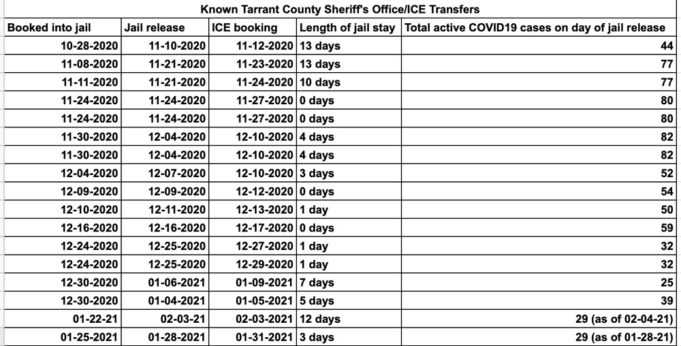There’s a lot of buzz revolving around the upcoming November elections for several important statewide positions, as well as several important positions within Tarrant County. As our community approaches the opportunity to elect a new Tarrant County Judge for the first time in 26 years, as well as two new commissioners, I encourage people to consider the power that these elected officials have as it relates to the 287(g) agreement in Tarrant County, which grants the sheriff’s office the power to carry out duties usually reserved for ICE (U.S. Immigration and Customs Enforcement) within the county jail and how the administration of this agreement has contributed to the spread of COVID-19.
As many people are aware, the 287(g) agreement, which has been in effect in Tarrant County since 2017, was initially voted into power by Judge Glen Whitley and Commissioners Gary Fickes and J.D. Johnson. In 2020, the agreement was renewed indefinitely, meaning that the commissioners court is no longer obligated to renew the agreement by voting for its renewal on a yearly or biyearly basis. The agreement is now administered solely under the discretion of the Tarrant County Sheriff’s Office, helmed by Sheriff Bill Waybourn. However, because the sheriff’s office works directly under the commissioners court and is supposed to report all matters related to the jail to them, the commissioners court still possesses multiple channels of power to hold the sheriff’s office accountable for their daily operations, including the administration of 287(g).
Toward the beginning of 2020, when the pandemic began to spread throughout the world, law enforcement agencies began adopting special provisions to mitigate the spread of the disease, especially as it related to the presence of COVID-19 within jails and other carceral facilities, because per guidance from the CDC (Centers for Disease Control and Prevention), these areas are ripe for the spreading of infections. From information obtained through an open records request by the ACLU of Texas, in partnership with the Texas Jail Project, all of the initial provisions adopted by the sheriff’s office to mitigate the spread of COVID-19 were shared with our organization, ICE Out of Tarrant, because of our efforts to hold the sheriff’s office accountable.
The policy that stood out to me the most from the affidavit shared by Chief Charles Eckert, who oversees the majority of daily jail operations, was No. 23, which read, “All new inmates to Tarrant County Jail are housed in a ‘classification’ housing unit for their first 14 days. These new inmates are medically checked daily for symptoms. Inmates stay in this housing unit until everyone has been in the housing unit for 14 days. Only then are they allowed to be placed in general population.”
However, according to information from the U.S. Department of Homeland Security, several people booked into Tarrant County Jail were released to ICE as soon as their first day of jail — some two days, others under 14 days. This practice by Tarrant County Jail exposed newly admitted people to COVID-19 by housing them in their classified housing units with other newly admitted people and then releasing them to ICE without allowing many of them to reach their 14-day clearance limit, leading to increased COVID-19 spread outside of the jail.
From data we obtained, many people booked into Tarrant County Jail were released to ICE in under 14 days, some people on the same day as their booking into Tarrant County Jail, which proves that the jail has been violating its own COVID-19 containment practices.
These numbers are just a fraction of what we believe constitutes the entire amount of ICE transfers made through the 287(g) agreement between May 31, 2020, and May 21, 2021.
To reiterate, our organization could not obtain a full understanding of these numbers because the sheriff’s office disrupted our initial investigation on the administration of 287(g) by removing public access to daily booked-in reports. We believe that this was intentional.
To illustrate the information in a more condensed manner, we have also created a table to offer a better view on how many people we know have been transferred to ICE who have been transferred before the 14-day holding limit. The table also illustrates how many people were infected with COVID-19 within Tarrant County Jail detention at the time that each of these individuals were transferred to ICE. The COVID-19 rate information was obtained using information from the Texas Commission on Jail Standards.
The Tarrant County Sheriff’s Office continued to maintain some records on the number of people in jail custody tested for COVID-19, as well as how many people have tested positive and other important pieces of information after the Texas Commission on Jail Standards ended this practice on June 16, 2021. It was discovered, months later, that the sheriff’s office was maintaining no records on how many people with ICE detainers were being tested for COVID-19 before being released to ICE custody via the 287(g) agreement.
After filing an open records request, we discovered that not only was the Tarrant County Sheriff’s Office violating their own rules that they created to mitigate the spread of COVID-19 through the administration of 287(g), but they also were not making any efforts to track which persons in their custody were tested for COVID-19 before being released to ICE custody.
In conclusion, as Tarrant County approaches its election cycle and as several positions on the commissioners court become up for grabs, our community must ensure that the people who are elected into power make a commitment to hold the sheriff’s department accountable and make a commitment to end the 287(g) agreement. The 287(g) agreement must end because it is racist in nature and upholds the structure of white supremacy, and it must end because it is detrimental to the public health of Tarrant County and very possibly several other areas throughout the nation and even other nations.
Signed,
Jonathan Guadian
Community organizer, ICE Out of Tarrant County
This letter reflects the opinions of the author and not the Fort Worth Weekly. To submit a letter, please email Editor Anthony Mariani at Anthony@FWWeekly.com. Letters will be gently edited for clarity and concision.









